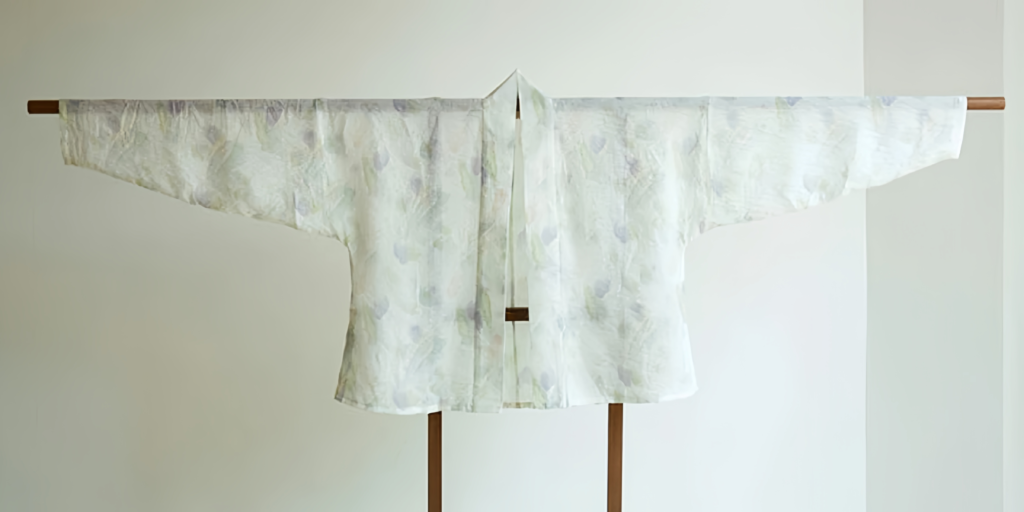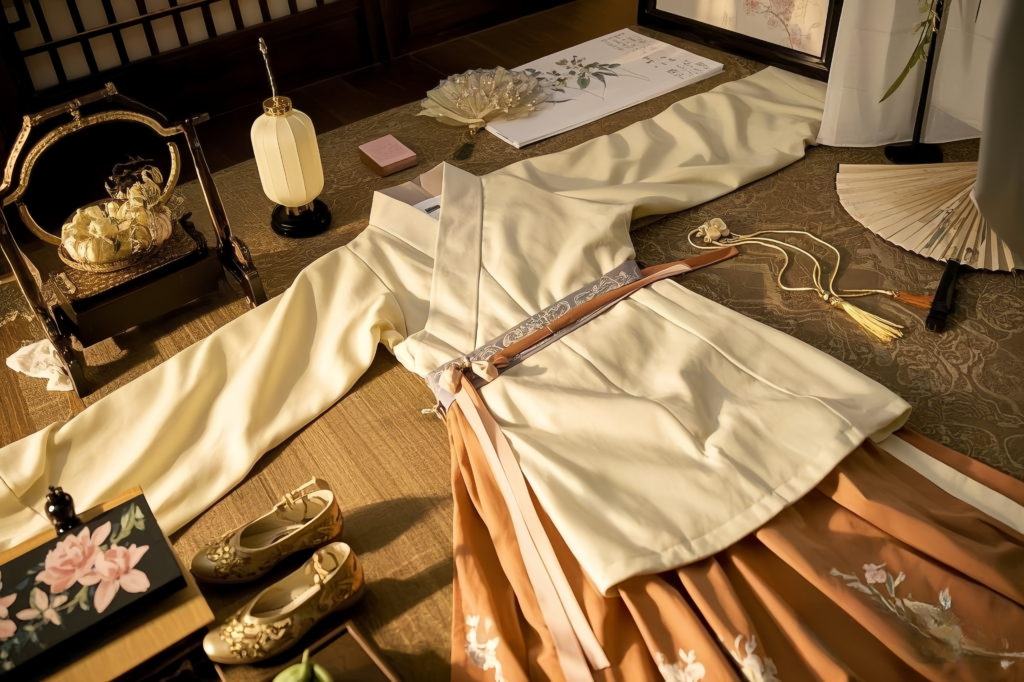Hanfu Sleeve Components

In the design of Hanfu sleeve styles, sleeves are a very important element. The shape and style of traditional sleeve designs have many variations, influenced by different historical periods and cultures. Today, we will introduce ten classic Hanfu sleeves, explore their historical backgrounds, and discuss potential evolutions. But before we dive in, let’s first go over some basic information about Hanfu sleeves that applies to (almost) all types.
Basic Structure of Hanfu Sleeves
One of the most notable features of Hanfu sleeve styles is the “connected sleeve” design (接袖). This means that the sleeves are not directly sewn onto the shoulders but are attached at a point halfway down the upper arm. The body of the garment and the sleeve’s fabric are made from the same piece of cloth. The other part of the sleeve is made from a different piece of cloth, and both are sewn together to form the complete sleeve.
The sleeve’s fabric is folded at the top and sewn at the bottom, creating a loose, flowing effect. Of course, there are exceptions, such as the half-sleeve (半袖), which may be too short to require a second piece of fabric to complete the sleeve. There are also garments without sleeves, where the sleeve ends right at the shoulder.
As for sleeve length, it varies greatly from dynasty to dynasty, but generally, it is determined by the occasion for which the traditional sleeve designs are worn. For casual or daily wear (休闲装), the sleeve length is typically about one hand’s length beyond the fingertips. For formal or ceremonial wear (礼服), the sleeve length should extend approximately to the length of the forearm beyond the fingertips.
To measure sleeve length, you can measure the arm length from fingertip to fingertip. For casual wear, add twice the hand’s length; for formal wear, add the length of the elbow plus the fingertip length, and then add twice that amount.
Now, let’s take a look at several classic Hanfu sleeves!
Narrow Sleeve (窄袖)
Let’s start with narrow sleeves. These sleeves are often referred to as “straight sleeves” (直袖) or “narrow sleeves” (窄袖). The sleeve itself is straight and doesn’t flare too much, sometimes narrowing slightly toward the wrist, making it narrower than at the shoulder. This style is commonly found in Zhongyi (中衣) and round-collar robes (圆领袍), and it’s not associated with a particular dynasty but rather appears in different forms across various periods.

Airplane Sleeve (飞机袖)
The name “airplane sleeve” (飞机袖) might sound modern, but it actually refers to a style that became popular during the Song Dynasty. The airplane sleeve narrows from the shoulder to the wrist, and the sleeve lies flat, resembling the wings of two airplanes. This historical sleeve style is usually found in the second or third layers of Song Dynasty women’s clothing, often paired with a straight collar (直领). The sleeve is wide and loose on the arms, making it easily recognizable.

Gongdai Sleeve (弓袋袖)
The “Gongdai sleeve” (弓袋袖) might not be a familiar term, but it is another type of narrow sleeve. This sleeve is slightly curved at the bottom, with narrower shoulders and wrists, yet it is more relaxed than the previous two styles. It is commonly seen in Ming Dynasty robes and jackets, and is considered a narrower version of the Pipa sleeve (琵琶袖) inherited from the Yuan Dynasty.

Wide Sleeve (大袖)
Wide sleeves (大袖) form a large category, referring to any sleeve with a very wide opening at the wrist. Many historical sleeve styles from the Ming Dynasty feature cuffs sewn up to the wrist to keep warm. The popular Da Xiu Shan clothing often features large wide sleeves, typically used as the outer layer of Hanfu. However, there are exceptions. For example, wide-sleeved coats (宽袖袄) from the Northern and Southern Dynasties (南北朝) were very popular and became an iconic silhouette.
Wide sleeves may gradually curve downward until the sleeve ends flat or may have a more angular cut at the wrist, leading to subcategories like Guangxiu (光袖) or square sleeves (方袖), which hang vertically from the shoulder and are almost straight down with little to no curve.

Pipa Sleeve (琵琶袖)
Have you heard of the Pipa? The Pipa is a pear-shaped musical instrument that is wide and round at the bottom, tapering toward the neck. Inspired by its shape, the Pipa sleeve (琵琶袖) features a similar silhouette, with narrower shoulders, a curved shape around the forearm, and a gradual narrowing toward the wrist. This sleeve became especially popular in the Ming Dynasty because it effectively kept the cold out of the sleeves, and it can be seen in many Ming Dynasty robes and jackets, making it one of the classic historical sleeve styles in Hanfu.

Drooping Sleeve (垂胡袖)
The term “drooping sleeve” (垂胡袖) may not be entirely accurate, but this style is similar to the Gongdai sleeve, with a slight downward curve at the wrist. However, the cuff of the drooping sleeve is flatter than the Gongdai sleeve. This style was commonly seen during the Qin Dynasty to the Jin Dynasty (秦朝至晋朝), and it is one of the rarer historical sleeve styles—you may spot it in Han Dynasty Quju robes (曲裾) or Wei-Jin Dynasty jackets (褂子). These sleeves typically have thicker, straight cuffs and sometimes use contrasting colors.

Straight Sleeve (直袖)
The straight sleeve (直袖) is simple to understand—it’s a sleeve where the width remains the same from the shoulder to the wrist. However, don’t underestimate the width of a straight sleeve; sometimes, the sleeve may be wide enough at the root that it also appears wide at the wrist! Unlike the narrow sleeve, which gradually tapers toward the wrist, straight sleeves remain wide throughout. You can see this style in almost any type of outerwear, but it is most common in Wei-Jin period tops and the inner layers of Hanfu across different dynasties, making it one of the classic Hanfu sleeves.

Bell Sleeve (喇叭袖)
The bell sleeve (喇叭袖) is another modern term, but it is essentially a simple design: imagine a narrow sleeve, but reversed. The sleeve starts narrow at the shoulder and gradually widens as it extends down to the wrist. You might wonder, what’s the difference between bell sleeves and wide sleeves? Well, wide sleeves typically have a much larger curve, often wide enough for your arms to stretch out and even touch the floor.
Bell sleeves, on the other hand, are usually shorter and extend only to the waist or hips, with a straight-line slope from the shoulder to the wrist instead of a curving line. This design makes bell sleeves one of the more iconic traditional sleeve styles seen across different Hanfu garments.

Half Sleeve (半袖)
Half sleeves (半袖) are defined by their length—half of the full sleeve length. Because they are too short, they might not need a second piece of fabric to form the sleeve. Half sleeves are usually straight or bell-shaped and are almost always worn as an outer layer.

Sleeveless (无袖)
And finally, sleeveless (无袖) garments—just as the name implies, these have no sleeves! There is no connecting piece, and the shoulder simply ends at the root. Sleeveless garments were common during the Ming Dynasty, often worn for formal occasions or in warmer weather, making them an interesting contrast to the more elaborate historical sleeve styles of other periods in Hanfu design.

These are some of the most common Hanfu sleeve styles found in traditional garments. From the sleek and subtle narrow sleeves to the bold and dramatic wide sleeves, each traditional sleeve designs carries a unique historical background and design aesthetic. For example, the Pipa sleeve (琵琶袖), which was highly popular during the Ming Dynasty, takes inspiration from the graceful curves of the pipa instrument, while the straight sleeve (直袖) from the Wei-Jin period remains more understated, maintaining a clean, straight line from the shoulder to the wrist.
Every historical sleeve styles offers a glimpse into the era it was worn in, with variations shaped by societal norms, weather, and fabric availability. Whether it’s the elegant and flowing lines of wide sleeves or the more structured look of narrow sleeves, each classic Hanfu sleeves reflects the fashion and functionality of its time, showcasing both beauty and practicality.
To learn more about Hanfu and its various components, check out this article on Hanfu history.





Responses